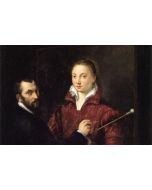Reimaging the Renaissance: strange pictures
Time: 10:30 - 12:30
Location: Keeley Street
- Course Code: VB937
- Dates: 05/06/24 - 10/07/24
- Time: 10:30 - 12:30
- Taught: Wed, Daytime
- Duration: 6 sessions (over 6 weeks)
- Location: Keeley Street
- Tutor: Emma Rose Barber
Course Code: VB937
Duration: 6 sessions (over 6 weeks)
Please note: We offer a wide variety of financial support to make courses affordable. Just visit our online Help Centre for more information on a range of topics including fees, online learning and FAQs.
What is the course about?
We often associate Renaissance painting with religious altarpieces – of the Madonna and Child or narratives telling stories about the lives and martyrdom of saints. We might also think of the mythological work of Botticelli. But these types of work tell only half the story. Reimagining the Renaissance seeks to consider a range of paintings that explore the strange, the wondrous, the weird, the fantasy and the plain ‘odd’. Many of the artists whose works are defined by these categories worked at the courts such as at Mantua, Ferrara and out of the way places such as Ascoli Piceno. This course is about another Renaissance – a type of art that often eludes our attention. We will try and understand what the subject matter, intentions and meanings behind the paintings were.
What will we cover?
• General introductions to the court art of Mantua and Ferrara where a lot of this type of art was made
• A discussion of the art - subject matter, styles and approaches
• A range of work by a range of artists who are less well-known than many of the Florentine artists we associate with the Renaissance.
What will I achieve?
By the end of this course you should be able to...
• Discuss something about court art and how to characterise it
• Identify some of the artists who painted the strange and wondrous Renaissance
• Speak confidently about works of art in a detailed and in-depth fashion
• Consider why court art had a ‘curious’ nature to it.
What level is the course and do I need any particular skills?
This course is suitable for all levels.
You should be able to follow simple written and verbal instructions, demonstrations, hand-outs and health and safety information, and will be invited to take part in group discussion.
How will I be taught, and will there be any work outside the class?
You will be taught with lecture, slide presentations and group discussions. Handouts will be provided by your tutor to support your learning on the course; these handouts will be available online/digitally for download via the college’s Google Classroom. You will be sent an invitation to join the Google Classroom within a week of the course start date.
Are there any other costs? Is there anything I need to bring?
You might wish to purchase a notebook for taking notes. You might wish to buy some of the books on any reading list provided.
When I've finished, what course can I do next?
The beauty of the medieval manuscript
Origins of the Italian Renaissance: The Primitivi.
Emma Rose Barber is an art historian who has been teaching adults for over 25 years. She specialises in the visual culture of the Middle Ages and the Italian and Northern Renaissance. She has also taught classes on British art and has designed many different courses such as Last Suppers in Florence and Bosch, Breughel and the Surrealists. She has also given lectures on Women and Art. She used to run the history of art department at the British Institute in Florence and works for many institutions such as the Open University, Morley College and the department of continuing education at the University of Oxford. Her book – 111 Churches that you Shouldn’t Miss in London - is coming out in the autumn of 2020. She has spent the last five years with a Mini A-Z looking for churches to write about, many of which can be found on her blog – https://theitinerantchurchgoer.wordpress.com/. She is also writing a Cultural History of Wayfaring and writes articles for Selvedge Magazine.
Please note: We reserve the right to change our tutors from those advertised. This happens rarely, but if it does, we are unable to refund fees due to this. Our tutors may have different teaching styles; however we guarantee a consistent quality of teaching in all our courses.
